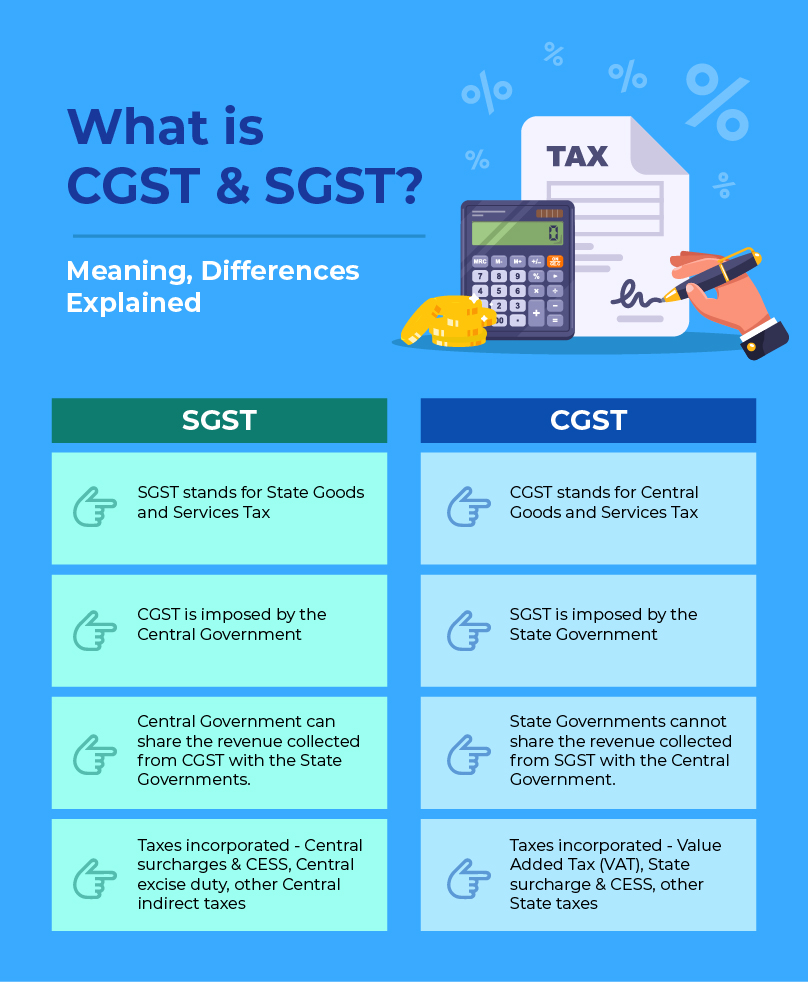GST is an everyday part of your life, which you pay for everything from the food you order online to the clothes you buy. You pay it on groceries, dining out, electronic, online shopping, movie tickets, and travel tickets. While GST has simplified the tax system, it is divided between different components, including CGST and SGST.
Whenever you purchase anything in your state, the Centre as well as the State collects a portion of the GST you pay. This blog explains in detail what CGST and SGST are, why they exist, and what are the main differences between CGST and SGST.
What is CGST and SGST?

Whenever you buy goods or services in your state, two elements of GST are charged simultaneously, Central GST (CGST) and State GST (SGST). The primary difference between CGST and SGST is that CGST is imposed by the central government, whereas SGST is imposed by the state government. This arrangement ensures that the revenue is shared equally between the Centre and the State.

What is CGST?
The full form of CGST is Central Goods and Services Tax. It is that part of GST that is paid to the Central Government. It gives the Centre its fair share of revenue from intra-state transactions, i.e., when goods or services are purchased and sold in the same state.
The GST you pay is divided equally between the State and the Centre. To illustrate, when you purchase furniture of ₹10,000 in Jaipur at 18% GST, the total GST will be ₹1,800. Of this, ₹900 is paid to the Centre as CGST, and the rest, ₹900, is paid to the State as SGST. The Central Government uses the revenue of CGST in national-level projects like highways, railways, defence, healthcare missions, and other welfare schemes that are beneficial to the country in general.
Also Read: SGST, CGST and IGST – What They Mean, How They Differ & Their Challenges
What is SGST?
SGST stands for State Goods and Services Tax. It is the amount of GST that the State Government collects. It is applicable to the same intra-state transactions as CGST, except that the revenue goes directly to the state in which the sale occurs.
Suppose you purchase sugar worth ₹5,000 in Bengaluru at 5% GST. The total GST will be ₹250. In this case, ₹125 is sent to the Centre in the form of CGST and ₹125 to the State of Karnataka in the form of SGST.
SGST revenue is used by states to fund local projects, including the construction of roads, schools, water supply systems, medical institutions, and other infrastructure that directly affects the lives of people in that state. Therefore, every time you buy in your state, you are paying two taxes simultaneously, CGST and SGST, but they are combined into one GST rate that you see on your bill.
Also Read: Labour Charges HSN Codes and GST Rates in India
Difference between CGST and SGST
Here is a short overview of the differences between CGST and SGST you must know as a taxpayer:
|
Features |
CGST |
SGST |
|
Full form |
Central Goods and Services Tax |
State Goods and Services Tax |
|
Imposing Authority |
Central Government |
State Government |
|
Collection Authority |
Central Government |
State Government |
|
Applies to |
Intra-state supply (Within state) |
Intra-state supply (Within state) |
|
Revenue Flow |
Central government may share with states |
State government does not share with government |
|
Share of Tax |
50% |
50% |
|
Accounting |
Separate in your GST return |
Separate in your GST return |
|
Collection Method |
Collected by supplier from buyer |
Collected by supplier from buyer |
|
Registration |
Required if turnover exceeds ₹20 lakh (₹10 lakh for northeastern states) |
Required if turnover exceeds ₹20 lakh (₹10 lakh for northeastern states) |
How CGST and SGST Impact Businesses and Individuals?
CGST and SGST directly impact businesses, paperwork, and even profitability. Every invoice, every return, and every pricing decision needs to reflect the dual nature of GST correctly.
Impact on Businesses
- The unified tax system prevents the complexity of having to operate with various indirect tax systems and jurisdictions.
- The input tax credit (ITC) has reduced the costs of operation and enhanced competitiveness in the market, thereby enabling new and smaller enterprises to expand more easily.
- Compliance has become digital and centralised, simplifying returns.
- Businesses have to separate the credits of CGST and SGST and make proper filing of intra-state transactions, which improves overall transparency.
Impact on Consumers
- CGST and SGST have led to transparent pricing where taxes are displayed in the ultimate prices, enabling consumers to make informed decisions.
- The tax system minimizes the indirect taxes' cascading effect, resulting in more stable price levels and usually lower prices on many basic goods and services.
Also Read: Administrative Structure of GST in India
Things to Keep in Mind as Taxpayers
Here are the key factors you must consider as a taxpayer:
- Changes in regulations and updates to GST rules are common, and businesses should regularly keep up with them.
- Input tax credit is only allowed on returns that suppliers duly file; invoices that are not matched or supplier non-compliance directly impact the cash flow of the business.
- Consumers must review invoices to see the GST breakdown (CGST and SGST) to be sure of fair pricing and to claim warranties or services on valid tax-compliant purchases.
- GST registration is required for both goods-based and services-based enterprises when their annual turnover is above the limit established.
- Businesses that are not required to undergo mandatory registration may still opt to undergo voluntary registration for GST.
Also Read: Maximise Your Tax Deductions Under Section 80D
To Conclude
All the intra-state transactions under GST are divided between the Centre and the State, ensuring both have funds to serve people. To businesses, this difference is a prerequisite to seamless compliance, proper invoicing, and equitable pricing.
Understanding the difference between CGST vs SGST will help businesses remain compliant and prevent errors, and concentrate on growth. To consumers, it serves as a reminder that each bill we pay makes our nation stronger as well as our state stronger.
Frequently Asked Questions
What is the primary difference between CGST vs SGST?
The primary difference between CGST vs SGST is that the central government collects the CGST and the state government collects the SGST on intra-state transactions.
How are CGST and SGST rates decided?
The GST Council determines the GST rate on a product or service and divides this rate equally between CGST and SGST; e.g., 18% GST will be 9% CGST and 9% SGST.
Are CGST and SGST to be paid separately by the consumers?
No, consumers see one GST amount on their bill. This division between CGST and SGST is managed internally by the government following collection.
What is the difference between IGST and CGST, and SGST?
IGST is applied to inter-state transactions or imports. CGST and SGST, on the other hand, are only applicable to intra-state transactions.
We take utmost care to provide information based on internal data and reliable sources. However, this article and associated web pages provide generic information for reference purposes only. Readers must make an informed decision by reviewing the products offered and the terms and conditions. Loan disbursal is at the sole discretion of Poonawalla Fincorp.
*Terms and Conditions apply